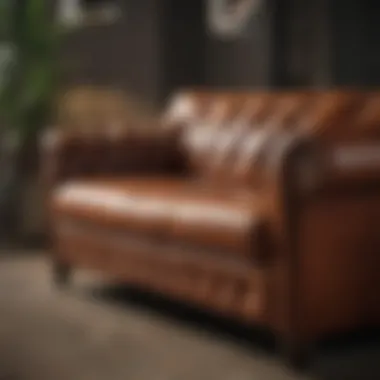Expert Techniques for Cleaning Leather Upholstery


Intro
Cleaning leather upholstery is not just an essential chore; it is a fiduciary responsibility to maintain one of the most luxurious materials found in furniture. Leather, with its unique texture and durability, offers both style and comfort. However, its maintenance requires a keen understanding of its properties and necessary care techniques. In this guide, we will explore the core principles of cleaning leather upholstery effectively. From identifying the correct cleaning materials to the most suitable methods based on leather type, the following sections will provide a well-rounded approach to leather care.
Understanding the different categories of leather is crucial. Each type, such as aniline, semi-aniline, and pigmented leather, has unique traits making it more or less suitable for specific cleaning agents and methods. Therefore, knowledge about these variations helps homeowners and design enthusiasts alike in preserving their leather for years.
In maintaining the beauty and integrity of leather, routine care cannot be overlooked. Seasonal maintenance checks and cleaning practices help in prolonging the life of leather pieces. This article aims to guide homeowners, interior design enthusiasts, and anyone keen on preserving their leather upholstery in navigating the complexities of his task.
Preamble to Leather Upholstery
Leather upholstery requires careful attention due to its unique characteristics and material properties. Understanding how leather works is essential for proper maintenance and cleaning. This section introduces the concept of leather upholstery, emphasizing its significance in enhancing the aesthetic appeal of a living space. Unlike synthetic materials, leather offers a timeless elegance and durability that can contribute to the overall value of furniture.
Understanding Leather Types
Leather is not a monolithic material; it comes in various types, each possessing distinct qualities. Some common types include full-grain, top-grain, corrected grain, and bonded leather. Full-grain leather is the highest quality, known for its natural imperfections, robustness, and ability to develop a beautiful patina over time. Top-grain leather is slightly sanded down, offering a more uniform look while still being durable. Corrected grain undergoes extensive finishing processes, making it less expensive but also less breathable. Finally, bonded leather consists of leather scraps bonded to a backing, which can result in lower quality.
Understanding these types is crucial as it dictates the kind of care and cleaning methods necessary. For instance, full-grain leather needs less frequent cleaning compared to bonded leather, which may require more rigorous maintenance due to its composite nature.
Importance of Regular Maintenance
Regular maintenance is vital for preserving the beauty and functionality of leather upholstery. When maintained properly, leather can last for decades, maintaining its aesthetic appeal and comfort. Over time, dirt, oils, and moisture can accumulate. This buildup can lead to discoloration, cracking, and even structural damage, which are often irreversible.
Performing routine cleaning can prevent long-term issues. Minimal attention, such as wiping down surfaces with a soft cloth and conditioning the leather every few months, can ensure its longevity. Moreover, regular maintenance can help to preserve the value of leather pieces, especially in a resale context.
Gathering Necessary Supplies
Gathering the right supplies is a crucial first step in cleaning leather upholstery. The effectiveness of your cleaning effort directly correlates with the quality of the tools and solutions you choose. Without the appropriate supplies, the cleaning process can be frustrating and ineffective, potentially causing damage to your leather. Therefore, selecting the right materials is fundamental to achieving a clean and well-maintained leather surface.
Cleaning Solutions
Commercial Leather Cleaners
Commercial leather cleaners play a significant role in leather care. These products are specifically formulated to address various types of stains and dirt without harming the leather. Their key characteristic lies in the balance of cleaning power and leather protection. Many of these cleaners include conditioners that help maintain the leather’s suppleness.
One unique feature of commercial leather cleaners is their formulation, which often includes pH-balanced ingredients. This ensures that the cleaner does not strip the leather of its natural oils. However, the disadvantages can include a higher cost compared to DIY options and the potential for some products to contain harsh chemicals that could be harmful in large applications. Thus, it is important to read labels carefully, opting for brands with a good reputation in the industry.
DIY Cleaning Solutions
DIY cleaning solutions are a popular alternative to commercial cleaners. They allow users a great deal of flexibility in choosing ingredients, which can be particularly advantageous for those concerned about using synthetic chemicals. Common ingredients might include vinegar, olive oil, or mild soap, which can effectively clean leather without the risks associated with harsher cleaners.
The main characteristic of DIY solutions is their accessibility and affordability. Many homeowners find items already present in their kitchens serve efficiently for leather cleaning, making it a cost-effective choice. Nonetheless, there are some risks involved. For instance, vinegar can be too acidic if used frequently, potentially damaging the leather over time. Therefore, it is essential to use DIY solutions judiciously and always test in an inconspicuous area first.
Cleaning Tools
Soft Cloths
Soft cloths are indispensable in the leather cleaning process. They contribute to avoiding scratches while applying cleaners and conditioning products. A key characteristic of soft cloths is their ability to trap dust and dirt without damaging the surface. Microfiber cloths are often the best choice for this task due to their gentle texture and high absorbency.
A unique feature of soft cloths is their versatility. They can be used for applying cleaner, wiping away excess cleaning agents, and buffing the leather after conditioning. The disadvantage may arise if the cloth becomes too soaked with cleaning solution, which can lead to uneven cleaning results along the leather surface.
Sponge
Sponge applicators are another important tool, especially for surface cleaning. They can hold more liquid compared to cloths, allowing for thorough application of liquids when cleaning. Sponages often feature a dual texture, enabling gentle scrubbing of tougher spots without damaging the leather's surface.
However, sponges can absorb dirt and oils over time, potentially leading to an inefficient cleaning process if not cleaned or replaced regularly. It’s crucial to choose a sponge that is as soft as possible, as rough textures can scratch the leather.
Brush
A brush specifically designed for leather can help in cleaning textured surfaces or removing debris from seams and crevices. The main characteristic of these brushes is their softer bristles, which provide effective cleaning without causing damage. Brushes can reach areas that cloths or sponges might miss, enhancing the overall cleaning process.


The unique advantage of using a brush is its ability to agitate the cleaning solution in those hard-to-reach areas, making it easier to lift dirt. However, if applied with too much pressure, even soft-bristled brushes can scratch delicate leather. Therefore, it’s critical to use them gently and observe the leather’s response during cleaning.
Preparing for Cleaning
Preparing leather upholstery for cleaning is a critical step that sets the foundation for effective maintenance. Neglecting this phase can lead to subpar results, and may even damage the material. Proper preparation involves understanding the specific condition of the leather and addressing any issues before applying cleaning solutions.
Assessing the Leather Condition
Assessing the condition of your leather before cleaning is essential. It allows you to tailor your cleaning methods to the specific needs of the material.
Identifying Stains
Identifying stains is a crucial part of assessing leather condition. It involves recognizing different types of stains that may have accumulated over time. This includes water marks, food spills, or ink stains. Each type of stain requires unique treatment methods, making the identification process very important.
By pinpointing the stain type, you can select the most effective cleaning solution. For example, water stains need different attention than oil stains. Recognizing these details is a one of the most beneficial aspects of this process. Conversely, failing to identify stains correctly can result in using inappropriate cleaning products, which may worsen the situation.
This identification process is a significant feature in the cleaning and maintenance strategy discussed in this article. It provides insights on customized care, enhancing the long-term durability of your leather upholstery.
Checking for Cracks or Damage
Checking for cracks or damage is another vital step in preparation. This involves visually inspecting the leather for any signs of wear and tear. Cracks compromise the integrity of the leather and, if left untreated, can lead to more extensive damage. This aspect is essential as it allows you to determine whether your cleaning process should include conditioning or repair treatments.
Identifying damage early can prevent expensive restorations later. It is critical to incorporate this aspect into your cleaning routine. Without assessing for damage, you may inadvertently worsen the overall condition.
Removing Loose Debris
Removing loose debris is the final preparatory measure. This includes dirt, dust, and crumbs that may have accumulated on the surface. Removing these particles is fundamental because they can scratch the leather during cleaning if not addressed. A soft brush or a vacuum cleaner with a brush attachment are excellent tools for this task.
By cleaning off loose debris, you ensure a smooth cleaning process. This simple step enhances the effectiveness of the cleaning solution applied later. All these preparatory actions culminate in creating an efficient and safe cleaning environment for your leather upholstery.
Step-by-Step Cleaning Process
The step-by-step cleaning process is vital for maintaining the quality and appearance of leather upholstery. Each phase in this process ensures that dirt, stains, and pollutants are effectively removed without compromising the leather's integrity. Accuracy in each step is essential to prevent potential damage.
The benefits of following a structured cleaning method include:
- Enhanced Aesthetic Appeal: A clean surface retains the richness of the leather, preserving its original look.
- Longevity: Regular cleaning prevents deterioration, extending the life of your upholstery.
- Health Considerations: A clean environment reduces allergens and irritants trapped in the upholstery.
Taking the time to follow a detailed approach allows for effective results that foster care and respect for one of the most luxurious materials available for furniture.
Applying the Cleaning Solution
When applying the cleaning solution, it is critical to choose a product that suits the type of leather you are cleaning. This first step sets the tone for the cleaning experience. For best results, use a soft cloth or sponge to apply the cleaner. Perform a patch test on a hidden area to ensure compatibility with the leather.
Wiping Down the Surface
After applying the cleaning solution, it is important to wipe down the surface thoroughly. Use a clean, dry cloth to gently remove any residue. This helps in preventing any buildup of cleaner that could harm the leather over time. Ensure to wipe with the grain of the leather, as this is where you will achieve the best results.
Treating Stubborn Stains
Stubborn stains can be challenging, but understanding how to tackle them systematically aids in successful treatment.
Grease and Oil Stains
Grease and oil stains are among the more troublesome types to address. Their greasy nature means they can easily penetrate the leather surface. Focus on absorbing the stain quickly with a dry cloth or paper towel. After, you can apply a mild solution to the stain, possibly a mixture of warm water and a few drops of gentle soap.
Key Characteristic: Their ability to seep deeper into the leather, making them harder to treat.
Advantages: If treated promptly with the right products, it is possible to minimize damage.


Pen Marks and Other Difficult Stains
Pen marks present another layer of complexity in leather care. The ink can be stubborn, often requiring specialized treatments. Start by dabbing the area with a cloth lightly moistened with rubbing alcohol, ensuring it doesn't soak into the leather too much.
Key Characteristic: Ink stains can leave a permanent mark if not treated properly or quickly.
Advantages: Some commercial leather ink removers are safe to use and can yield effective results when applied correctly.
While the stress of cleaning leather can be intimidating, understanding the proper methods can greatly improve your cleaning outcomes.
Drying and Conditioning Leather
Proper drying and conditioning of leather upholstery is essential for maintaining its appearance and extending its life. After cleaning, leather can lose its natural oils, making it prone to cracking and fading. Conditioning helps restore these oils, keeping the material supple and healthy. Moreover, drying techniques play a critical role in preventing water damage and mold growth. Understanding these processes is necessary for those who own leather furniture.
Importance of Drying Techniques
Drying leather properly is critical after cleaning. Excess moisture can lead to a range of issues, including mildew and an unpleasant smell. Ideally, leather should air dry away from direct sunlight or heat sources, as these can cause the material to dry too quickly and possibly crack. Natural air circulation allows the leather to dry evenly, preserving its structure.
- Avoid Heat: Never use a blow dryer or place leather near heaters.
- Gentle Patting: Use a soft cloth to dab excess moisture gently.
Employing the right drying techniques ensures the longevity of leather. It protects the fibers and helps maintain its aesthetic appearance.
Conditioning after Cleaning
Conditioning leather after it has been cleaned is an integral part of leather care. This process enriches the material, helping it to stay flexible and resistant to wear. Leather conditioners typically contain oils that penetrate the surface, replenishing lost moisture.
Choosing the Right Conditioner
Selecting an appropriate conditioner is vital for the quality of the leather. Not all conditioners are universally suitable. Look for a product that is specifically designed for the type of leather you have.
- Key Characteristics: A good conditioner should be pH-balanced and free of harsh chemicals. This characteristic allows it to nourish leather without causing damage.
- Benefits: By using the right conditioner, you ensure that your leather remains soft, reducing the risk of cracks and keeping it looking new.
- Unique Features: Some conditioners include UV protection, guarding against sun damage. However, conditioners that are too oily can lead to buildup if used too frequently.
Application Method
The method of applying leather conditioner can affect its effectiveness. Use a soft cloth to apply the product evenly over the surface of the leather to ensure thorough coverage.
- Key Characteristics: The application should be done using circular motions to allow better absorption.
- Benefits: Proper application enhances the conditioning's penetration into the leather, promoting healthier material.
- Unique Features: Avoid saturating the leather with too much conditioner to prevent excessive residue. A light, even layer is usually sufficient for effective conditioning.
To maintain the beauty and longevity of leather upholstery, never underestimate the power of proper drying and conditioning techniques.
By following these drying and conditioning tips, homeowners and leather enthusiasts can keep their leather furniture looking and feeling its best for years. Investing time and effort into these maintenance steps pays off, as it retains the aesthetic appeal and functional quality of the leather.
Preventive Measures for Leather Upholstery
When it comes to maintaining leather upholstery, prevention is always better than cure. Taking proactive measures can extend the life of your leather furniture and keep it looking its best. Applying the right preventive strategies ensures that you minimize damage and neglect, which can both lead to costly repairs or even replacement.
Implementing preventive measures involves not just occasional general cleaning but establishing a deeper understanding of the types of treatments leather requires. Recognizing the importance of specific protective products and setting up a regular cleaning regime greatly contribute to the endurance of leather upholstery.
Using Protective Products
Utilizing protective products designed specifically for leather is essential to fend off stains and preserve the material’s texture. Products such as leather protectants create a barrier against spills, dirt, and UV rays. Here are some critical components to consider:
- Leather protectants: These keep the leather supple while repelling moisture and dirt.
- Conditioners: Using a good conditioner helps maintain moisture levels in the leather, preventing cracks or brittleness over time.
Applying these products regularly will enhance the leather's resilience. It is important to select high-quality items designed specifically for your type of upholstery. This attention to quality ensures that products do not inadvertently damage the leather.
Establishing a Cleaning Schedule
Establishing a cleaning schedule is not just useful; it is vital for maintaining leather upholstery. Regular care prevents buildup of dirt and oils, which can be difficult to remove if neglected. Here is how to effectively create a schedule:


- Frequency: Designate specific intervals for cleaning. Generally, light cleaning should occur bi-weekly, while more thorough cleaning might be needed every three months.
- Check-ups: Regularly inspect the upholstery for any signs of wear or damage. Early detection can make repair easier and less costly.
- Seasonal Adjustments: Depending on the climate you live in, adapt your cleaning schedule to include special preparations during different seasons. For example, in humid conditions, mold can become a problem.
Ultimately, cleanliness not only preserves the appearance but also extends the lifespan of the upholstery. Consistency in preventive maintenance is key to enjoying your leather furniture for years to come.
Special Considerations for Different Environments
When it comes to maintaining leather upholstery, the environment in which it is used plays a significant role in the care and longevity of the material. Understanding how the home setting contrasts with commercial use is essential for developing an effective cleaning strategy. Equally important is recognizing how climate factors affect leather care. This section will discuss these special considerations and provide guidance tailored to specific environments.
Home Use vs. Commercial Use
In residential settings, leather upholstery often faces less wear and tear compared to that used in commercial environments. Home furniture tends to be used in a more controlled manner, with less frequent movement and usually fewer individuals interacting with it daily. These factors allow for less aggressive cleaning regimes, focusing primarily on routine maintenance and spot cleaning rather than deep cleans.
In contrast, furniture in commercial spaces, such as restaurants, hotels, or offices, frequently endures a higher volume of traffic. Consequently, leather upholstery in these settings may require more robust cleaning techniques.
- Higher Traffic: The upholstery in commercial areas sees daily exposure to various dirt and oils from increased interaction.
- More Frequent Cleaning: Establish a regular cleaning schedule to address spills, stains, and dirt promptly.
- Durability Needs: Choose leather types that are more resilient to wear and can endure rigorous cleaning methods without degrading their quality.
For both environments, it is crucial to understand each setting's unique challenges. Homeowners can focus on preventive measures, while commercial users may need to invest in more intensive care routines. By identifying the differences, an appropriate cleaning strategy can be created to address specific needs effectively.
Climate Impact on Leather Care
The climate in which the leather upholstery resides also influences its care requirements significantly. Extreme temperatures and humidity levels can affect leather's moisture content, which in turn impacts its appearance and feel.
- Dry Climates: Leather can dry out and lose its natural oils in arid conditions. In such instances, conditioning the leather regularly is vital to prevent cracking and peeling.
- Humid Areas: High humidity can lead to mold and mildew growth. Cleaning must include a method to inhibit such growth, which may involve using specialized cleaning products designed for these conditions. Employing dehumidifiers in such settings can be beneficial.
- Temperature Fluctuations: Rapid changes in temperature can cause leather to expand and contract, potentially leading to damage. Maintaining a stable environment with controlled temperatures will help preserve leather.
Understanding how both home versus commercial use and climate factors into the equation helps leather owners make informed decisions on care regimens. Tailoring maintenance practices to suit the specific environment will maximize the lifespan and appearance of leather upholstery.
Common Mistakes in Leather Care
Leather upholstery can offer elegance and durability, but it requires proper care to maintain its appeal. Understanding common mistakes in leather care is essential for preserving the integrity of your pieces. By being informed, you can avoid costly damage and ensure your leather furniture looks good for years. Below are two major pitfalls that many encounter.
Using Harsh Chemicals
One prevalent mistake is the use of harsh chemicals when cleaning leather. These include products that contain ammonia, bleach, or strong solvents. While these substances may clean other surfaces effectively, they can cause irreparable harm to leather. Harsh chemicals strip away natural oils, resulting in dryness and cracking. Furthermore, they can alter the leather's color, leading to uneven patches and blemishes.
Instead, it’s advisable to opt for pH-balanced leather cleaners. These products are specifically designed to maintain the leather's integrity without damaging its finish. DIY solutions like a mixture of water and mild soap can also prove effective, as long as they are used in moderation. Take care to always test a small, inconspicuous area before applying any cleaner widely.
Using gentle products is always safer for your leather. Avoid any strong chemical cleaners.
Over-cleaning
Another issue arises from over-cleaning leather upholstery. This may seem counterintuitive, but frequent cleaning can lead to more harm than good. Many homeowners may clean their leather pieces at every visible sign of dirt or stain. While keeping leather clean is necessary, excessively rubbing or scrubbing can remove essential oils and protective coatings. Moreover, over-cleaning can wear down the gentle surface, resulting in a dull appearance.
For optimal care, establish a regular cleaning schedule that aligns with the usage of your furniture. Spot clean only when absolutely necessary, focusing on the specific areas that need attention. Regular dusting with a soft cloth can often suffice, eliminating the need for rigorous cleaning. Remember, leather, while sophisticated, does benefit from a measured approach in care.
By identifying and avoiding these common mistakes, you will significantly enhance the longevity and beauty of your leather upholstery.
Closure
Cleaning leather upholstery is not just a functional task but a vital aspect of maintaining the elegance and longevity of your furniture. Understanding the complexity of leather care helps homeowners, interior design enthusiasts, and other stakeholders appreciate their investments better. This section summarizes the cleaning processes while emphasizing best practices that can help in preserving leather for the long term.
Recap of Cleaning Process and Best Practices
The journey to clean leather upholstery begins with a careful assessment of the leather's current condition. Identifying stains and checking for any cracks should be done first. This initial evaluation ensures that you're aware of any damage that may need special treatment. After that, gather the necessary supplies, including soft cloths, sponges, and cleaning solutions—either commercial or DIY.
Once equipped, follow the step-by-step cleaning process meticulously:
- Apply the cleaning solution: Use the solution suited to your leather type. Apply it evenly with a soft cloth.
- Wipe down the surface: Ensure all areas are cleaned, moving in a circular motion to avoid streaks.
- Treat stubborn stains: For marks that resist cleaning, targeted methods are needed, such as using specific solutions for grease or ink stains.
- Dry: Always allow the leather to dry naturally away from direct heat sources to prevent cracking.
- Condition: Regular conditioning keeps the leather supple, using appropriate products tailored to each leather variant.
Following these best practices will enhance the appearance of your leather upholstery and prolong its life, keeping it looking new and inviting for years.
Encouragement for Ongoing Care
Maintaining leather upholstery requires a commitment to ongoing care. Regular cleaning with the right techniques can mitigate damage from everyday use. Establishing a cleaning routine tailored to your environment—such as more frequent cleanings in high-traffic areas—will protect the leather's integrity.
Invest in protective products specifically designed for leather. These products create a barrier against spills and stains, making maintenance easier. A proactive approach will save you from significant repairs later on. Moreover, educating yourself continually about leather care can help you make informed decisions when needed.







